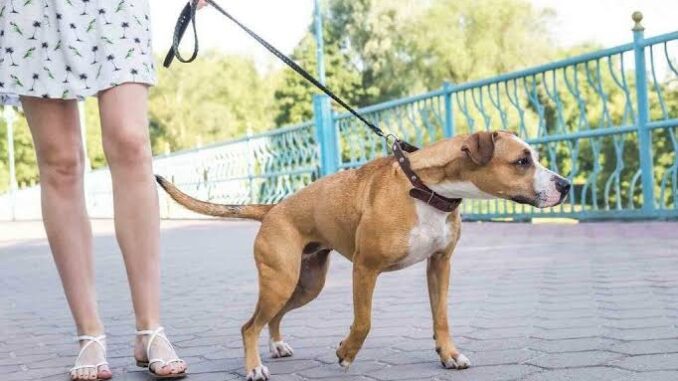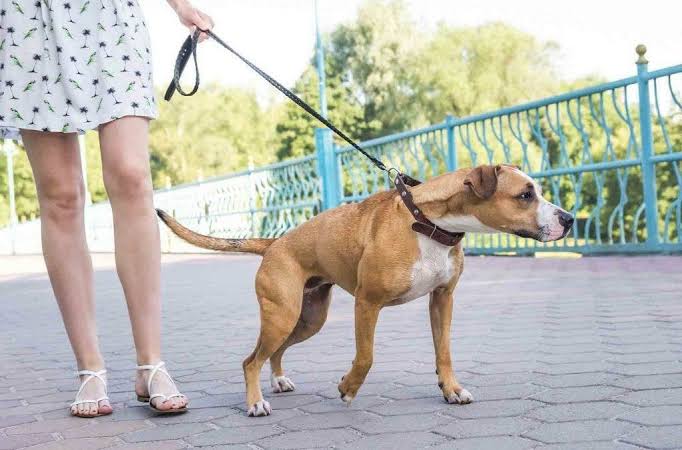
Tips for Walking a Reactive Dog: Walking a reactive dog can feel like navigating a minefield. Whether your dog lunges, barks, or freezes at the sight of other dogs, strangers, or loud noises, it can make daily walks stressful for both of you. But with the right techniques, tools, and patience, walks can become a source of enrichment instead of anxiety.

This comprehensive guide offers 10 practical tips for walking a reactive dog.
What is a Reactive Dog?
A reactive dog overreacts to certain stimuli in their environment like other dogs, people, cars, or loud noises. Unlike aggression, reactivity is rooted in fear, overstimulation, or frustration. Signs of reactivity include:
- Barking or growling
- Lunging or pulling
- Whining or pacing
- Fixating on triggers
- Trying to flee or freeze
While any dog can be reactive, breeds with strong guarding, herding, or prey instincts may show heightened responses. The goal isn’t to “cure” reactivity but to manage and reduce it through training and thoughtful strategies.
Tip 1: Choose the Right Walking Gear
Standard collars are not ideal for reactive dogs. Instead, consider:
- Front-clip harness: Redirects pulling without pressure on the neck.
- Head halter (like Gentle Leader): Offers more control but requires acclimation.
- Double-clip leash: Attaches to both front and back harness points for added stability.
- Treat pouch: Always be ready to reward calm behavior or distract from triggers.
Avoid retractable leashes, which can be dangerous with reactive dogs.
Tip 2: Understand Your Dog’s Triggers
Keep a log of what causes your dog to react. Triggers can include:
- Other dogs
- People (men, children, people in hats)
- Noises (skateboards, loud engines)
- Fast movements (joggers, cyclists)
Understanding your dog’s “reactivity threshold” helps you predict and prevent reactions. Stay far enough away so your dog notices the trigger but doesn’t react.
Tip 3: Pick the Right Walking Time and Place
Walk during quieter times—early mornings, mid-day, or after sunset—to avoid crowds. Choose:
- Quiet streets or nature trails
- Low-traffic parks
- Empty parking lots
Avoid busy paths, dog parks, or high-stimulus areas during training.
Tip 4: Use Distance as Your Ally
Distance helps your dog stay under threshold. If your dog notices a trigger without reacting, praise and reward. As they progress, you can slowly reduce the distance over time. This desensitization is part of counter-conditioning—changing their emotional response to triggers.
Tip 5: Practice the “Look at That” Game
This technique teaches your dog that looking at a trigger results in a treat, shifting their focus from reaction to anticipation of reward.
How it works:
- Your dog sees a trigger from a distance.
- You say “Yes!” or click and offer a treat before your dog reacts.
- Repeat until your dog starts looking at you for the treat automatically.
This builds positive associations with previously scary stimuli.
Tip 6: Master Redirection Techniques
Sometimes you won’t have the luxury of space. In those moments, redirect your dog:
- Hand target: Teach your dog to touch your hand with their nose for treats.
- Find it game: Drop several treats on the ground and say “Find it!” to shift focus.
- Emergency U-turn: Practice turning quickly and walking in the opposite direction with an upbeat tone.
The goal is not to distract constantly, but to give your dog tools to cope when needed.
Tip 7: Keep Training Sessions Short and Positive
Avoid marathon walks when your dog is reactive. Start with short, successful sessions and build up gradually.
- 10–15 minutes is plenty for early training walks.
- Focus on quality over distance.
- End the walk on a positive note—even if you only get down the block.
Reinforce calm behavior with praise and high-value rewards.
Tip 8: Use Calming Products if Needed
While not a cure, certain products can take the edge off your dog’s anxiety:
- Adaptil collars or sprays (mimic calming pheromones)
- Calming treats or chews with L-theanine or chamomile
- Thundershirts (gentle pressure garments)
- CBD for dogs (consult your vet first)
These aids may help create a more balanced baseline during walks.
Tip 9: Advocate for Your Dog in Public
Don’t be afraid to say “no” to strangers who want to pet your dog or approach too closely. You can also use visual cues like:
- A yellow leash or bandana (signals “Give us space”)
- Tags or vests that say “Nervous Dog” or “Do Not Pet”
It’s your responsibility to keep your dog and others safe. Be proactive, confident, and respectful while setting boundaries.
Tip 10: Consult a Certified Trainer or Behaviorist
Working with a professional—especially one who uses positive reinforcement—can be a game changer. Look for credentials like:
- CPDT-KA (Certified Professional Dog Trainer)
- IAABC member
- Fear Free Certified Professional
A trainer can tailor a desensitization and counter-conditioning plan to your dog’s needs, speeding up progress and reducing stress for both of you.
READ ALSO: The Advantages of Neutering or Spaying Your Dog
Bonus: Celebrate Small Wins
Reactive dog training can feel slow, but progress is often incremental. Celebrate victories like:
- Calmly walking past a trigger at a distance
- Looking at you instead of barking
- Staying focused during a “Find it” game
Reinforce these moments. They’re building blocks to long-term change.
FAQs
Can reactive dogs ever become “normal”?
While reactivity may never fully disappear, most dogs can improve significantly with training, consistency, and management. Many owners report their dogs become calmer and more confident over time.
Is reactivity the same as aggression?
No. Reactive behavior stems from fear, excitement, or overstimulation. Aggression is more deliberate and often includes biting or intent to harm. However, unchecked reactivity can escalate, which is why early intervention matters.
How long does it take to see improvement?
Every dog is different. Some may show progress in a few weeks; others take months. Consistency, patience, and working below threshold are key.
Should I use a muzzle on my reactive dog?
If your dog poses a risk of biting, a basket muzzle (properly fitted and introduced positively) can be a safe, humane option. Muzzles protect both your dog and the public while allowing for training to continue.
My dog reacts to everything what should I do?
Begin with one trigger at a time and manage the environment. Choose low-distraction settings, reward calm behavior, and work on reducing intensity gradually. Seek professional help if needed.
Should I let my dog “meet” other dogs to fix reactivity?
No. Forcing interactions often makes things worse. Instead, focus on creating neutral, non-confrontational exposure from a distance and reward your dog for staying calm.
Is off-leash time bad for reactive dogs?
Not necessarily, but it depends on your dog and the setting. A secure, private area (like a fenced yard or empty field) can be therapeutic. Avoid off-leash public areas, especially dog parks, unless your dog is well-managed and confident.
Leave a Reply
You must be logged in to post a comment.